| Join | Official Historian | City of Stamford | Blog | About Us | |
| Jewish Historical Society | Civil War Roundtable | Contact Us | |
|
|
|
|
The Stamford Historical Society PresentsPortrait of a Family: Stamford through the Legacy of the DavenportsThe Later 18th Century and Stamford’s American RevolutionThe population of Stamford grew dramatically during the second half of the 18th century. In 1756 there were 2768 people, this rose to 3563 by 1774 and finally to 4051 by 1790. During this same time there was a decline in the African-American population from 120 in 1754, to 56 in 1762 and finally 60 in 1774. By 1791 there were only 46 slaves and 27 free blacks in Stamford, some 1.5% of the population, a figure that was to stay constant until 1900. The white population continued to be virtually entirely of English descent and overwhelmingly was made up of farmers. Families were interrelated to a great degree due to the predominance of consanguineous marriage. While a small number of men were accumulating great wealth through trade, primarily in agricultural goods, most remained tied to the land, and land continued to be a great source of wealth. Craft industries continued to flourish, but all on a small scale. While more mills were constructed on Stamford’s rivers during this time, they continued mostly to serve the needs of the local populace. Abraham Davenport Leads Stamford through the RevolutionThe most powerful man in the Stamford area during this time, and certainly the most visible, was Abraham Davenport. Son of Rev. John, he went on to hold virtually every important post in Stamford, as well as judgeships at the county level. He also served in the Connecticut State government. Davenport was able to manipulate his positions in such a way as to increase his own wealth and made tidy profits in trade during the French and Indian War. By 1775 he was the wealthiest property owner in Stamford. During the Revolution he further amassed wealth. As Judge of Probate he had a hand in the confiscation of Loyalist lands that were subsequently sold at auction. As Judge of the Maritime Court at Fairfield he had a part in the distribution of wealth derived from prizes taken at sea. Yet Stamford benefited by having a man such as Abraham represent it as he had the ear of Governor Jonathan Trumbull and was able to help provide for Stamford’s safety during the Revolution.
|
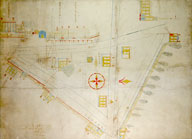 Map of Stamford, 1823 |
Connecticut was the fourth state to ratify the United States Constitution. The General Assembly ordered delegates sent from the towns in 1787. John and James Davenport, the sons of Abraham, were sent to represent Stamford. On January 4, 1788 the Constitution was ratified.
Stamford in 1800 was still fairly small, with a population only slightly over 4,000. Of the total, 10% of the population (77 families) lived in the area around Atlantic Square. There were four general stores to maintain the populace and five schools town-wide. Between 1800 and 1840 there were actually few changes to the town, but a number of them were significant. In May of 1801, those areas of Stamford belonging to Canaan Parish were permanently severed, becoming part of the town of New Canaan. Stamford lost some 1500 people. In 1820 Middlesex Parish successfully split away to form the town of Darien, causing Stamford a loss of over 1200 people. This reduced Stamford’s total area to 38 square miles, its current size. The population reflects the losses. From a high of 4440 people in 1810, Stamford’s population was stagnant till the middle of the 19th century: 3284 (1820); 3707 (1830); 3516 (1840).
Improvements in Transportation and the Role of John Davenport Jr.
One of the few major changes to the town was the improvement in transportation. By the 1820s regular service by water was provided to New York City. Efforts to improve ground transportation had also been made. In 1805, the Connecticut Turnpike Company had been formed by John Davenport Jr. and had put forward a plan to improve and straighten the Post Road such that it would go through the center of town. The proposed route took the road through the colonial graveyard, necessitating the movement of the stones to another locale. Many felt this desecration of the cemetery was unacceptable, and in 1805 the Stamford Town Meeting petitioned the General Assembly to deny Davenport the right to construct the turnpike. The General Assembly ultimately voted to permit Davenport to construct the pike between Byram and Fairfield citing the need to improve roads throughout the area. After a series of protests and obstacles the road went through. It is ironic that here a John Davenport was a driving force for change and modernization, given his namesakes were traditionalists and conservatives.
Another change was the continuing diversity of religious practices. In 1811, the Quakers, who had been present since colonial times, built their first meetinghouse. The Methodists followed suit in 1813. The First Methodist edifice was built in the center of town also.
The Borough of Stamford 1830-1848
By 1830 Stamford’s population had grown to 3,707 people, of which 633 were concentrated in the downtown area around Atlantic Square and along the main thoroughfare constructed earlier by Davenport’s Connecticut Turnpike Co. There were in this area 68 dwellings, 4 churches, 11 stores and shops, 1 public school, 5 private schools, a Town House, a printing office, a flour mill, a tannery and 3 iron rolling mills. The needs of the downtown area and the concentration of population there led to the creation of the borough of Stamford as a separate entity in 1830. The town and borough together formed the area of Stamford but special levies and taxes were made in the borough to attend to the streets, law enforcement and urban improvements. The borough form of government would continue in force until 1893 with the establishment of the City of Stamford. Town and City would continue to maintain separate police forces and other services until their merging in 1949.
Stamford during this period was a town dominated overwhelmingly by residents of English ancestry, many of whom were descendants of the first families in the area. In fact, one-third of the population was made up of people with the last names of Scofield, Smith, Lockwood, Weed, Hoyt and June. This period witnessed further religious diversification with the founding of the Universalist Church in 1833.
Between 1824 and 1842 the Stamford budgets were kept between $900 and $1700 every year, except for the year when the town undertook the construction of a Town House to serve as the administrative office of the town. In 1870 this house was sold as a private home and replaced by a proper Town Hall built on Atlantic Square.
Industry and Commerce to 1848
Industry continued to be underdeveloped. With the exception of the flour mills on Cove Island that belonged to John Holly, that were said to be the largest in the state, between 1791 and 1843 the only other large scale operations were grist mills, sawmills, wiremills and the iron rolling mills. One of the earliest maps of the town, drawn by another Holly in 1837 shows a downtown with a mere 169 buildings, mostly private homes, but that also included 61 stores, 4 iron manufacturers, the Town House, and the Stage House, an establishment that served the traffic on the Post Road.
A major development in town was the establishment in 1834 of a local bank. In March of that year a public meeting had been held in support of the idea. The General Assembly granted a charter for the bank in 1834 provided the bank pay $5,000 to Wesleyan University in two installments. The Stamford Bank, which in 1865 became the First Stamford National Bank and Trust Co., was thereupon established and grew into a major financial institution rapidly under one of its first directors, Theodore Davenport.
Also on display in the exhibit:
Payment For Stationing Troops At Stamford
Receipt signed June 12, 1779 by Captain Jesse Bell for “480 pounds L. M. [lawful money] for the use of his company of guards stationed at Stamford. … by the hand of the Honble Abraham Davenport Esq.”
The fear of British incursions made it necessary to station Connecticut troops in many shoreline towns at various times during the war. The British did raid Greenwich in February 1779, and less than a month after this document was written, they also burned Fairfield, Greens Farms and Norwalk.
Gift of Mr. and Mrs. Charles R. Bowen
Payment For Stationing Troops At Stamford
Receipt signed June 12, 1779 by Captain Jesse Bell for “480 pounds L. M. [lawful money] for the use of his company of guards stationed at Stamford. … by the hand of the Honble Abraham Davenport Esq.”
The fear of British incursions made it necessary to station Connecticut troops in many shoreline towns at various times during the war. The British did raid Greenwich in February 1779, and less than a month after this document was written, they also burned Fairfield, Greens Farms and Norwalk.
Gift of Mr. and Mrs. Charles R. Bowen
Powder Horn
This beautifully scratch-carved powder horn marked Shrewsbury and Alexander Bishop, his horn, July 3rd, 1747, is a reminder of the military struggles between the French and the British prior to the American Revolution.
There are no records to show how many men from Stamford were among the three thousand soldiers called into service from Connecticut during the French and Indian Wars, which did not end until 1763.
Abraham Davenport played an important role during this period, serving on a town committee required to furnish the 250 Highland soldiers quartered in Stamford with supplies from November 30, 1757 until March 30, 1758.
Estate of Miss Fannie E. Wardwell
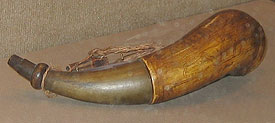 |
 |
A Map of the Village of Stamford 1837, Executed by Wm. H. Holly
William Henry Holly (1798-1867) served Stamford as editor and publisher of the Stamford Advocate, county surveyor, appraiser and proprietor of a lending library. In addition, he held other situations as auctioneer, Town Clerk, communal orator at festive occasions, member of the State Commission on the boundary dispute between New York and Connecticut, bookseller and Judge of Probate.
Gift of Mr. & Mrs. Rockwell Gardiner
G221-107
Constitution of Stamford Mutual Insurance Company
New York, (1797?)
Aware of the danger of fire in the growing village and anxious to reduce the high cost of insurance coverage, a mutual fire insurance company was formed by John Davenport, Jr., David Maltbie, Samuel Jarvis, George Mills and John Wm. Holly. The constitution of the Stamford Mutual Insurance Co., dated Feb. 20, 1797, limited it to houses valued at $500 or more. Policies were to be activated when 30 subscribers signed. It is not known if the company actually got going.
Stamford Historical Society
Sketches of the life of the late Rev. Samuel Hopkins, D. D., pastor of the First Congregational church in Newport, written by himself, interspersed with marginal notes extracted from his private diary; …
Published by Stephen West, 1805
Shaw & Shoemaker, 1805
(No. 8640)
Rev. Dr. Hopkins was instrumental in helping to solidify the work of this infant parish during the final years of the Revolutionary War. It continues today as the North Stamford Congregational Church.
“I spent great part of the summer of 1777…And early in the spring I went to Stamford, to a destitute congregation, to which I preached during the summer of 1778. And in the fall of that year I left the old town of Stamford, and preached to a parish in the same town, then called Woodpecker-Ridge, now called North Stamford. Here I had my wife and one daughter with me, and continued here through the winter and summer of 1779, and the winter of 1780. In the spring of that year my wife and daughter went to Great Barrington and I went to Newport, the British having left it the fall before.” Samuel Hopkins, p. 77.
Lent by The Pequot Library, Southport
| Hourglass
The Stamford Historical Society |
Leather Fire Bucket,
c. 1810-1830
The Stamford Historical Society |
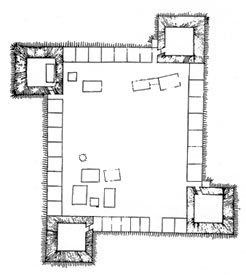 Fort Stamford
Fort Stamford 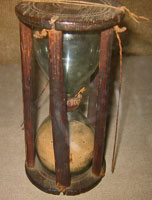 This 18th century timepiece is made of blown glass in a pine frame. It was found near Lisbon, Connecticut.
This 18th century timepiece is made of blown glass in a pine frame. It was found near Lisbon, Connecticut. 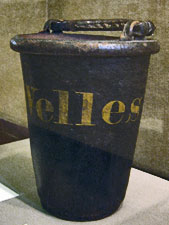 Major Melancton Woolsey Welles was born in Stamford, Connecticut in 1770, son of the Reverend Noah and Abigail Woolsey Welles. In 1809, he moved to Lowville in upstate New York where he kept an inn until about 1830. This fire bucket was used in the inn. Welles continued to reside in Lowville until his death in 1857.
Major Melancton Woolsey Welles was born in Stamford, Connecticut in 1770, son of the Reverend Noah and Abigail Woolsey Welles. In 1809, he moved to Lowville in upstate New York where he kept an inn until about 1830. This fire bucket was used in the inn. Welles continued to reside in Lowville until his death in 1857.